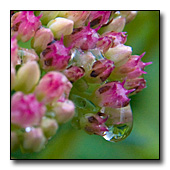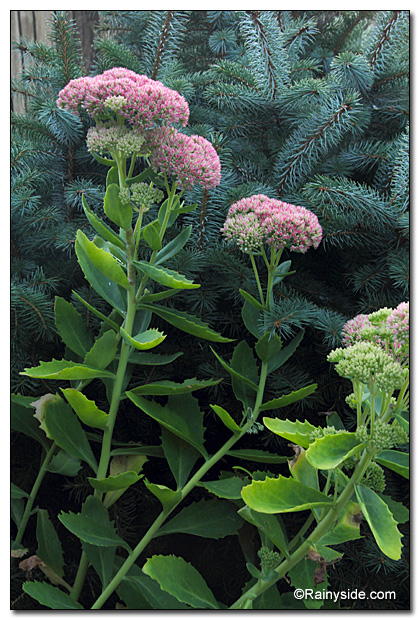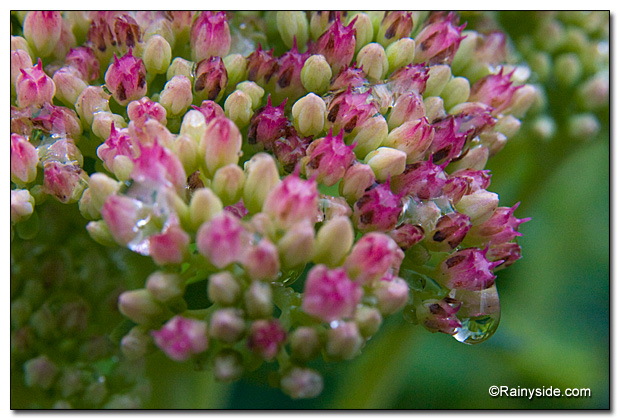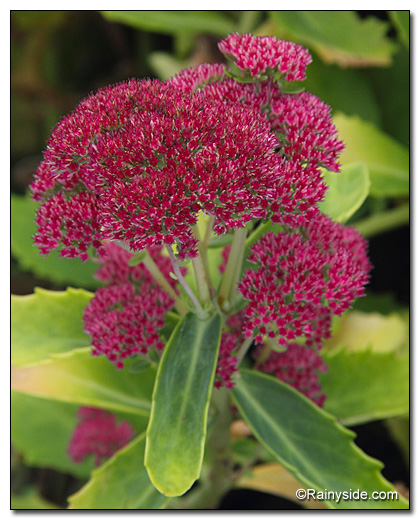Sedum 'Autumn Fire'
STONECROP
syn. Hyloptelephium 'Autumn Fire'
Family: Crassulaceae
Pronounced: SAY-dum

Quick Jumps
Growing Guide
Rainy Side Notes
GROWING GUIDE

Origin:
Garden.
Plant group:
Perennials.
Hardiness:
Sunset zones: 1-10, 14-24.
USDA zones: 5-8.
Heat zones: 10-1.
Mature size:
Height: 18-24 inches (45-60 cm).
Width: 18-24 inches (45-60 cm).
Flowering period:
Late summer to fall.
Flowering attributes:
Flower heads form in July and the flat corymbs look like broccoli. In August, the flowers start to color up, turning pink. Slowly the flowers turn red, and later in fall they turn a deeper rusty-red.
Leaf attributes:
Green, succulent, oblong to ovate leaves with toothed margins.
Growth habit:
Upright.
Light:
Full sun to partial shade.
Soil:
Light, well-drained soil.
Feeding:
Not a heavy feeder, so I give it a complete organic fertilizer in spring and side dress with compost or manure.
Propagation methods:
Stem cuttings.
Division.
My favorite: In early spring pull a rosette off the main plant and transplant the small rosette to a new area in the garden.
Pruning methods:
No pruning is necessary except to clean up dead stems in late fall. If you leave the plant intact over winter, prune out dead stems in early spring before new growth begins. If you accidentally pull up a rosette while pruning, see propagation method above.
Rainy Side Notes


According to some sources Sedum 'Autumn Fire' is supposed to be shorter than S. 'Autumn Joy'. In my own garden, the opposite is true; 'Autumn Fire' wins the tallest-sedum-in-the-garden contest over its elder. The flowers are a little brighter rose pink then ‘Autumn Joy’s’. Nevertheless, they are similar enough to each other that I would have a hard time identifying which one, when planted alone. Growing next to the dwarf Picea ‘Pappoose’ (top right photo), the sedum sets off the bluish-green needles of the conifer; a nice contrast I rather enjoy.
The nomenclature is still a mess on the tall sedums—they've been placed in the Hylotelephium genus, but I haven't seen the industry following suit on the name change yet, so I keep them listed as everyone knows them under the genus Sedum.
It is an easy plant to grow; the flowers add a lot of color to the late summer and fall garden. For best results, grow the tall sedums in full sun. Planted in partial shade, they become leggy and tend to topple over. However, this can also be an indication that it is time to divide the plant.
Debbie Teashon
Photographed in author's garden.

Gardening for the Homebrewer: Grow and Process Plants for Making Beer, Wine, Gruit, Cider, Perry, and More
By co-authors Debbie Teashon (Rainy Side Gardeners) and Wendy Tweton
Copyright Notice | Home | Search | Perennials

